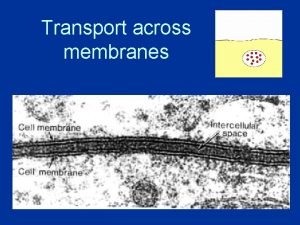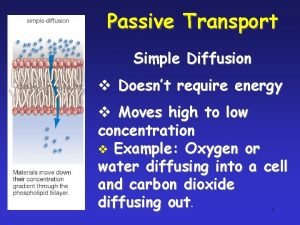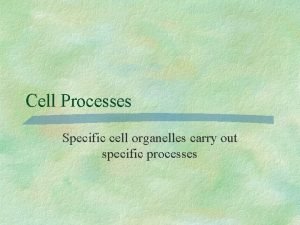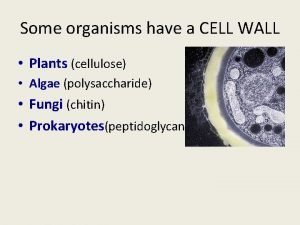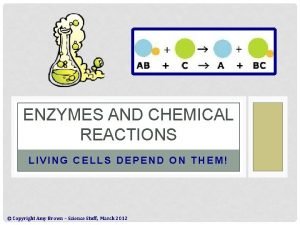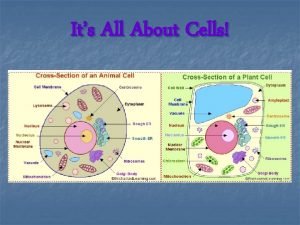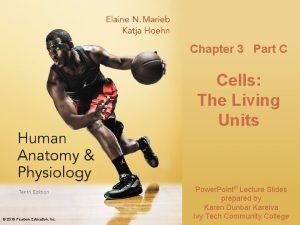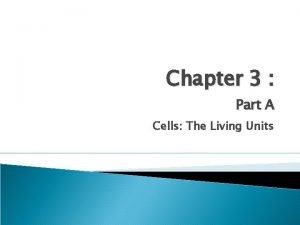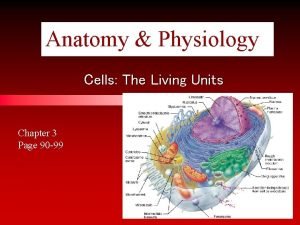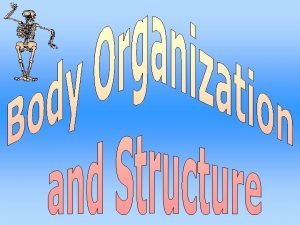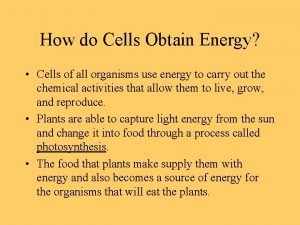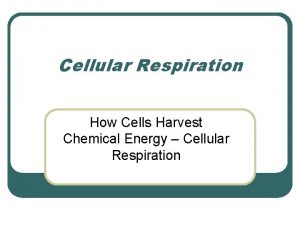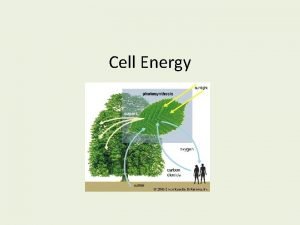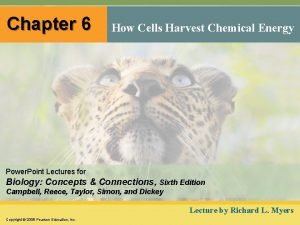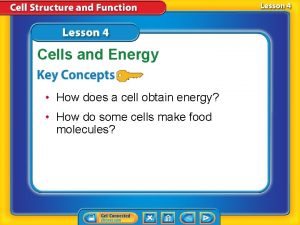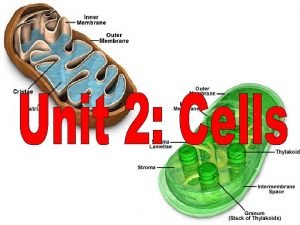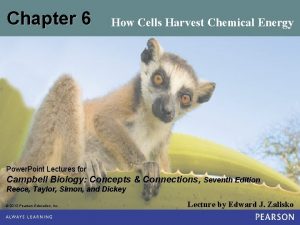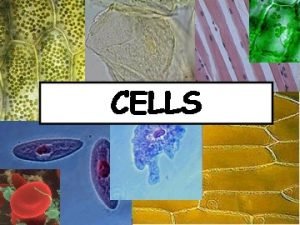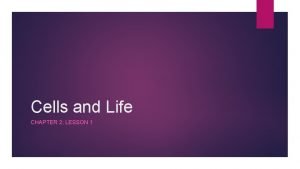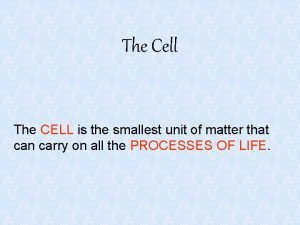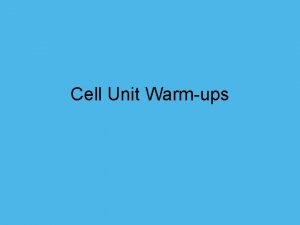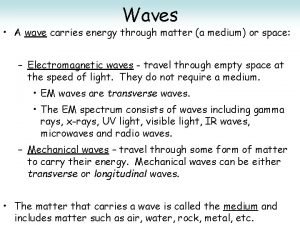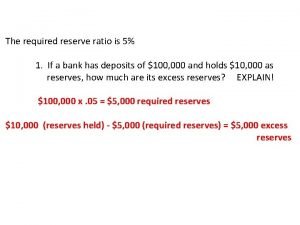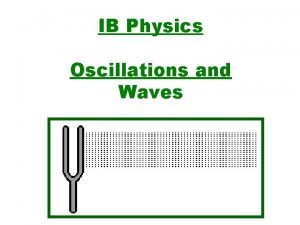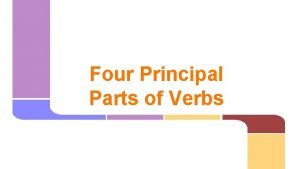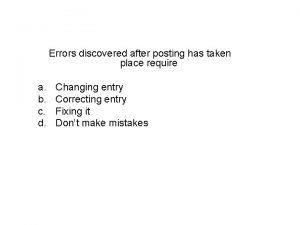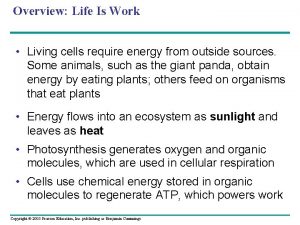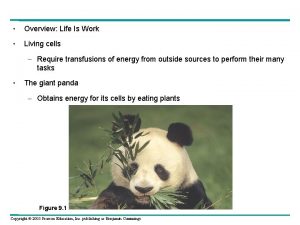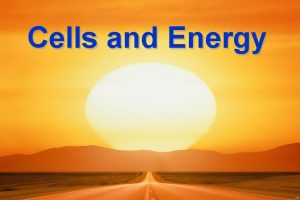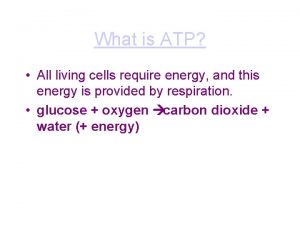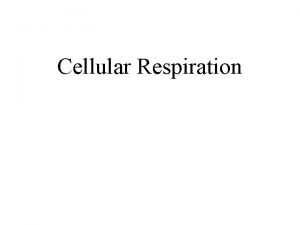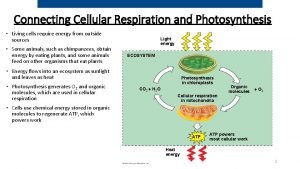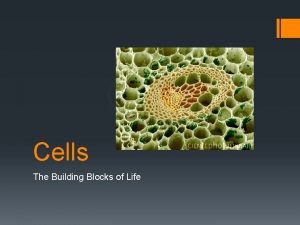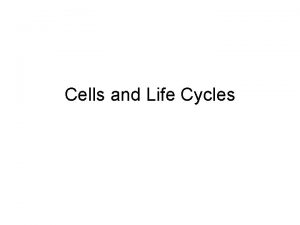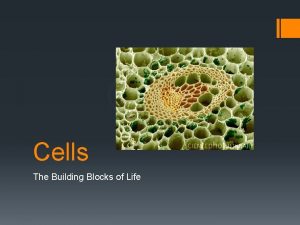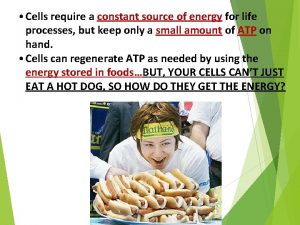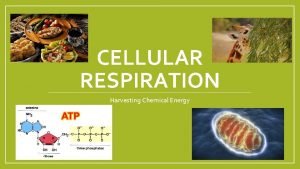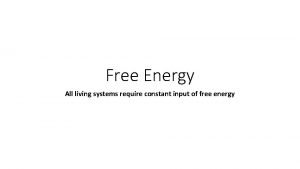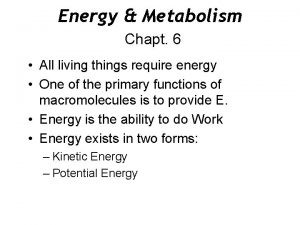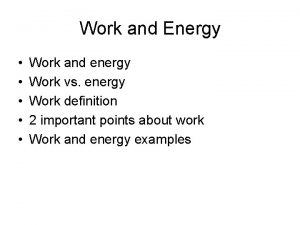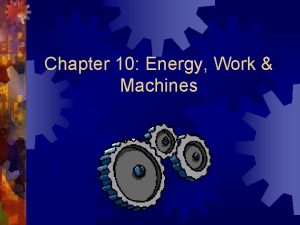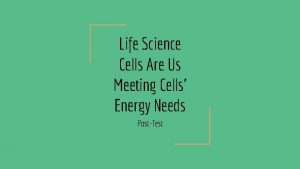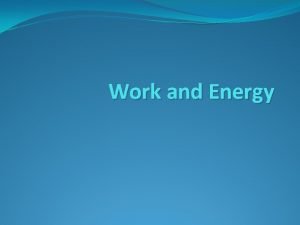Overview Life Is Work Living cells require energy


























































- Slides: 58

Overview: Life Is Work • Living cells require energy from outside sources • Some animals, such as the giant panda, obtain energy by eating plants, and some animals feed on other organisms that eat plants • Energy flows into an ecosystem as sunlight and leaves as heat • Photosynthesis generates oxygen and organic molecules, which are used in cellular respiration • Cells use chemical energy stored in organic molecules to regenerate ATP, which powers work Copyright © 2005 Pearson Education, Inc. publishing as Benjamin Cummings

LE 9 -2 Light energy ECOSYSTEM Photosynthesis in chloroplasts CO 2 + H 2 O Cellular respiration in mitochondria Organic + O molecules 2 ATP powers most cellular work Heat energy

Catabolic Pathways and Production of ATP • The breakdown of organic molecules is exergonic • Fermentation is a partial degradation of sugars that occurs without oxygen • Cellular respiration consumes oxygen and organic molecules and yields ATP • Although carbohydrates, fats, and proteins are all consumed as fuel, it is helpful to trace cellular respiration with the sugar glucose: C 6 H 12 O 6 + 6 O 2 6 CO 2 + 6 H 2 O + Energy (ATP + heat) Copyright © 2005 Pearson Education, Inc. publishing as Benjamin Cummings

Redox Reactions: Oxidation and Reduction • The transfer of electrons during chemical reactions releases energy stored in organic molecules • This released energy is ultimately used to synthesize ATP Copyright © 2005 Pearson Education, Inc. publishing as Benjamin Cummings

The Principle of Redox • Chemical reactions that transfer electrons between reactants are called oxidation-reduction reactions, or redox reactions • In oxidation, a substance loses electrons, or is oxidized • In reduction, a substance gains electrons, or is reduced (the amount of positive charge is reduced) becomes oxidized (loses electron) Xe- + Y X + becomes reduced (gains electron) Copyright © 2005 Pearson Education, Inc. publishing as Benjamin Cummings Ye-

• The electron donor is called the reducing agent • The electron receptor is called the oxidizing agent Copyright © 2005 Pearson Education, Inc. publishing as Benjamin Cummings

• Some redox reactions do not transfer electrons but change the electron sharing in covalent bonds • An example is the reaction between methane and oxygen Copyright © 2005 Pearson Education, Inc. publishing as Benjamin Cummings

LE 9 -3 Products Reactants becomes oxidized CH 4 2 O 2 + CO 2 C Energy 2 H 2 O + becomes reduced H H + H O O O C O H Methane (reducing agent) Oxygen (oxidizing agent) Carbon dioxide Water H

Oxidation of Organic Fuel Molecules During Cellular Respiration • During cellular respiration, the fuel (such as glucose) is oxidized and oxygen is reduced: becomes oxidized C 6 H 12 O 6 + 6 O 2 6 CO 2 + 6 H 2 O + Energy becomes reduced Copyright © 2005 Pearson Education, Inc. publishing as Benjamin Cummings

Stepwise Energy Harvest via NAD+ and the Electron Transport Chain • In cellular respiration, glucose and other organic molecules are broken down in a series of steps • Electrons from organic compounds are usually first transferred to NAD+ (nicotinamide adenine dinucleotide), a coenzyme • As an electron acceptor, NAD+ functions as an oxidizing agent during cellular respiration • Each NADH (the reduced form of NAD+) represents stored energy that is tapped to synthesize ATP Copyright © 2005 Pearson Education, Inc. publishing as Benjamin Cummings

LE 9 -4 2 e– + 2 H+ NAD+ 2 e– + H+ H+ NADH Dehydrogenase + 2[H] (from food) Nicotinamide (oxidized form) + Nicotinamide (reduced form) H+

Fig. 9 -UN 4 Dehydrogenase Copyright © 2005 Pearson Education, Inc. publishing as Benjamin Cummings

• NADH passes the electrons to the electron transport chain • Unlike an uncontrolled reaction, the electron transport chain passes electrons in a series of steps instead of one explosive reaction • Oxygen pulls electrons down the chain in an energy-yielding tumble • The energy yielded is used to regenerate ATP Copyright © 2005 Pearson Education, Inc. publishing as Benjamin Cummings

LE 9 -5 H 2 + 1 / 2 O 2 + 2 H 1 /2 O 2 (from food via NADH) ATP tran ATP rt spo Free energy, G ron Explosive release of heat and light energy t Elec Free energy, G 2 H + + 2 e– Controlled release of energy for synthesis of ATP in cha 2 e– 2 H+ H 2 O Uncontrolled reaction H 2 O Cellular respiration

The Stages of Cellular Respiration: A Preview • Cellular respiration has four stages: – Glycolysis (breaks down glucose into two molecules of pyruvate) – Pyruvate conversion (pyruvate is changed into acetyl Co. A for entry into citric acid cycle) – The citric acid cycle (completes the breakdown of glucose) – Oxidative phosphorylation (accounts for most of the ATP synthesis) • The process that generates most of the ATP is called oxidative phosphorylation because it is powered by redox reactions Copyright © 2005 Pearson Education, Inc. publishing as Benjamin Cummings

LE 9 -6_1 Glycolysis Pyruvate Glucose Cytosol Mitochondrion ATP Substrate-level phosphorylation

LE 9 -6_2 Glycolysis Pyruvate Glucose Cytosol Citric acid cycle Mitochondrion ATP Substrate-level phosphorylation

LE 9 -6_3 Electrons carried via NADH and FADH 2 Electrons carried via NADH Glycolysis Pyruvate Glucose Cytosol Citric acid cycle Oxidative phosphorylation: electron transport and chemiosmosis Mitochondrion ATP ATP Substrate-level phosphorylation Oxidative phosphorylation

• Oxidative phosphorylation (indirect ATP synthesis) accounts for almost 90% of the ATP generated by cellular respiration • A small amount of ATP is formed in glycolysis and the citric acid cycle by substrate-level phosphorylation (direct ATP synthesis) Copyright © 2005 Pearson Education, Inc. publishing as Benjamin Cummings

LE 9 -7 Substrate level phosphorylation - direct synthesis of ATP Enzyme ADP P Substrate + Product ATP

Step 1: Glycolysis • Glycolysis (“splitting of sugar”) breaks down glucose into two molecules of pyruvate • Glycolysis occurs in the cytoplasm and has two major phases: – Energy investment phase – Energy payoff phase Copyright © 2005 Pearson Education, Inc. publishing as Benjamin Cummings

LE 9 -8 Energy investment phase Glucose Glycolysis Citric acid cycle 2 ADP + 2 P 2 ATP used Oxidative phosphorylation Energy payoff phase ATP ATP 4 ADP + 4 P 2 NAD+ + 4 e– + 4 H+ 4 ATP formed 2 NADH + 2 H+ 2 Pyruvate + 2 H 2 O Net Glucose 4 ATP formed – 2 ATP used 2 NAD+ + 4 e– + 4 H+ 2 Pyruvate + 2 H 2 O 2 ATP 2 NADH + 2 H+

LE 9 -9 a_1 Glucose ATP Hexokinase ADP Glucose-6 -phosphate Glycolysis Citric acid cycle ATP Oxidation phosphorylation ATP

LE 9 -9 a_2 Glucose ATP Hexokinase ADP Glucose-6 -phosphate Phosphoglucoisomerase Fructose-6 -phosphate ATP Phosphofructokinase ADP Fructose 1, 6 -bisphosphate Aldolase Isomerase Dihydroxyacetone phosphate Glyceraldehyde 3 -phosphate Glycolysis Citric acid cycle ATP Oxidation phosphorylation ATP

LE 9 -9 b_1 2 NAD+ Triose phosphate dehydrogenase 2 NADH + 2 H+ 1, 3 -Bisphoglycerate 2 ADP Phosphoglycerokinase 2 ATP 3 -Phosphoglycerate Phosphoglyceromutase 2 -Phosphoglycerate

LE 9 -9 b_2 2 NAD+ Triose phosphate dehydrogenase 2 NADH + 2 H+ 1, 3 -Bisphoglycerate 2 ADP Phosphoglycerokinase 2 ATP 3 -Phosphoglycerate Phosphoglyceromutase 2 -Phosphoglycerate 2 H 2 O Enolase Phosphoenolpyruvate 2 ADP Pyruvate kinase 2 ATP Pyruvate

Step 2: Pyruvate Conversion • Before the citric acid cycle can begin, pyruvate must be converted to acetyl Co. A, which links the cycle to glycolysis Copyright © 2005 Pearson Education, Inc. publishing as Benjamin Cummings

LE 9 -10 MITOCHONDRION CYTOSOL NAD+ NADH + H+ Acetyl Co A Pyruvate Transport protein CO 2 Coenzyme A

Step 3: The Citrate Cycle (a. k. a. Krebs Cycle) • The citric acid cycle, also called the Krebs cycle, takes place within the mitochondrial matrix • The cycle oxidizes organic fuel derived from pyruvate, generating one ATP, 3 NADH, and 1 FADH 2 per turn Copyright © 2005 Pearson Education, Inc. publishing as Benjamin Cummings

LE 9 -11 Pyruvate (from glycolysis, 2 molecules per glucose) CO 2 NAD+ NADH + H+ Glycolysis Citric acid cycle ATP Oxidation phosphorylation Co. A Acetyl Co. A Citric acid cycle FADH 2 2 CO 2 3 NAD+ 3 NADH + 3 H+ FAD ADP + P i ATP

• The citric acid cycle has eight steps, each catalyzed by a specific enzyme • The acetyl group of acetyl Co. A joins the cycle by combining with oxaloacetate, forming citrate • The next seven steps decompose the citrate back to oxaloacetate, making the process a cycle • The NADH and FADH 2 produced by the cycle relay electrons extracted from food to the electron transport chain Copyright © 2005 Pearson Education, Inc. publishing as Benjamin Cummings

LE 9 -12_1 Glycolysis Citric acid cycle ATP Oxidation phosphorylation ATP Acetyl Co. A H 2 O Oxaloacetate Citrate Isocitrate Citric acid cycle

LE 9 -12_2 Glycolysis Citric acid cycle ATP Oxidation phosphorylation ATP Acetyl Co. A H 2 O Oxaloacetate Citrate Isocitrate CO 2 Citric acid cycle NAD+ NADH + H+ a-Ketoglutarate NAD+ Succinyl Co. A NADH + H+ CO 2

LE 9 -12_3 Glycolysis Citric acid cycle ATP Oxidation phosphorylation ATP Acetyl Co. A H 2 O Oxaloacetate Citrate Isocitrate CO 2 Citric acid cycle NAD+ NADH + H+ Fumarate a-Ketoglutarate FADH 2 NAD+ FAD Succinate GTP GDP ATP Pi Succinyl Co. A NADH + H+ CO 2

LE 9 -12_4 Glycolysis Citric acid cycle ATP Oxidation phosphorylation ATP Acetyl Co. A NADH + H+ H 2 O NAD+ Oxaloacetate Malate Citrate Isocitrate CO 2 Citric acid cycle H 2 O NAD+ NADH + H+ Fumarate a-Ketoglutarate FADH 2 NAD+ FAD Succinate GTP GDP ATP Pi Succinyl Co. A NADH + H+ CO 2

Step 4: Oxidative Phosphorylation • Following glycolysis and the citric acid cycle, NADH and FADH 2 account for most of the energy (potential energy) extracted from food • These two electron carriers donate electrons to the electron transport chain, which powers ATP synthesis via oxidative phosphorylation (powered by redox reactions) Copyright © 2005 Pearson Education, Inc. publishing as Benjamin Cummings

The Pathway of Electron Transport • The electron transport chain is in the inner mitochondrial membrane of the mitochondrion • Most of the chain’s components are proteins, which exist in multiprotein complexes • The carriers alternate reduced and oxidized states as they accept and donate electrons • Electrons are passed to protein complexes (that increase in electronegativity (increased desire to possess electrons)) as they go down the chain and are finally passed to the ultimate electron acceptor O 2 (most electronegative), forming H 2 O Copyright © 2005 Pearson Education, Inc. publishing as Benjamin Cummings

LE 9 -13 NADH 50 Free energy (G) relative to O 2 (kcal/mol) FADH 2 40 FMN I Multiprotein complexes FAD Fe • S II Fe • S Q III Cyt b 30 Fe • S Cyt c 1 Glycolysis Citric acid cycle ATP Oxidative phosphorylation: electron transport and chemiosmosis IV Cyt c Cyt a 20 Cyt a 3 10 0 2 H+ + 1/2 O 2 H 2 O ATP

• The electron transport chain generates no ATP • The chain’s function is to break the large freeenergy drop from food to O 2 into smaller steps that release energy in manageable amounts Copyright © 2005 Pearson Education, Inc. publishing as Benjamin Cummings

Chemiosmosis: The Energy-Coupling Mechanism • Electron transfer in the electron transport chain causes proteins to pump H+ from the mitochondrial matrix to the intermembrane space • H+ then moves back across the membrane, passing through channels in ATP synthase • ATP synthase uses the exergonic flow of H+ to drive phosphorylation of ATP • This is an example of chemiosmosis, the use of energy in a H+ gradient to drive cellular work Copyright © 2005 Pearson Education, Inc. publishing as Benjamin Cummings

• The energy stored in a H+ gradient across a membrane couples the redox reactions of the electron transport chain to ATP synthesis • The H+ gradient is referred to as a proton-motive force, emphasizing its capacity to do work Copyright © 2005 Pearson Education, Inc. publishing as Benjamin Cummings

LE 9 -14 INTERMEMBRANE SPACE H+ H+ H+ A rotor within the membrane spins as shown when H+ flows past it down the H + gradient. H+ A stator anchored in the membrane holds the knob stationary. A rod (or “stalk”) extending into the knob also spins, activating catalytic sites in the knob. H+ ADP + Pi MITOCHONDRAL MATRIX ATP Three catalytic sites in the stationary knob join inorganic phosphate to ADP to make ATP.

LE 9 -15 Inner mitochondrial membrane Glycolysis Citric acid cycle ATP Oxidative phosphorylation: electron transport and chemiosmosis ATP H+ H+ H+ Intermembrane space H+ Cyt c Protein complex of electron carriers Q III I II FADH 2 Inner mitochondrial membrane NADH + H+ IV ATP synthase FAD 2 H+ + 1/2 O 2 H 2 O NAD+ Mitochondrial matrix ATP ADP + P i (carrying electrons from food) H+ Electron transport chain Electron transport and pumping of protons (H+), Which create an H+ gradient across the membrane Oxidative phosphorylation Chemiosmosis ATP synthesis powered by the flow of H+ back across the membrane

An Accounting of ATP Production by Cellular Respiration • During cellular respiration, most energy flows in this sequence: glucose NADH electron transport chain protonmotive force ATP • About 40% of the energy in a glucose molecule is transferred to ATP during cellular respiration, making about 32 ATP • The variability in whether 30 or 32 total ATP are generated per 1 molecule of glucose depends on which of two shuttle pathways is used to transfer electrons from NADH in the cytosol, generated during glycolysis, to either NAD+ or FAD (one shuttle passes electrons to NAD+ to generate NADH and the other shuttle passes electrons to FAD to generate FADH 2) - see following Figure 9. 16* Copyright © 2005 Pearson Education, Inc. publishing as Benjamin Cummings

LE 9 -16 * Electron shuttles span membrane CYTOSOL 2 NADH Glycolysis Glucose 2 Pyruvate MITOCHONDRION 2 NADH or 2 FADH 2 2 NADH 2 Acetyl Co. A 6 NADH Citric acid cycle + 2 ATP by substrate-level phosphorylation Maximum per glucose: About 30 or 32 ATP 2 FADH 2 Oxidative phosphorylation: electron transport and chemiosmosis + about 26 or 28 ATP by oxidation phosphorylation, depending on which shuttle transports electrons form NADH in cytosol

Concept 9. 5: Fermentation enables some cells to produce ATP without the use of oxygen • Cellular respiration requires O 2 to produce ATP • Glycolysis can produce ATP with or without O 2 (in aerobic or anaerobic conditions) • In the absence of O 2, glycolysis couples with fermentation to produce ATP • Additionally, anaerobic respiration uses an electron transport chain with an electron acceptor other than O 2, for example sulfate • Fermentation uses phosphorylation instead of an electron transport chain to generate ATP Copyright © 2005 Pearson Education, Inc. publishing as Benjamin Cummings

Types of Fermentation • Fermentation consists of glycolysis plus reactions that regenerate NAD+, which can be reused by glycolysis • Two common types are alcohol fermentation and lactic acid fermentation Copyright © 2005 Pearson Education, Inc. publishing as Benjamin Cummings

• In alcohol fermentation, pyruvate is converted to ethanol in two steps, with the first releasing CO 2 • Alcohol fermentation by yeast is used in brewing, winemaking, and baking Copyright © 2005 Pearson Education, Inc. publishing as Benjamin Cummings

LE 9 -17 a 2 ADP + 2 P i Glucose 2 ATP Glycolysis 2 Pyruvate 2 NAD+ 2 Ethanol Alcohol fermentation 2 NADH + 2 H+ 2 CO 2 2 Acetaldehyde

• In lactic acid fermentation, pyruvate is reduced to NADH, forming lactate as an end product, with no release of CO 2 • Lactic acid fermentation by some fungi and bacteria is used to make cheese and yogurt • Human muscle cells use lactic acid fermentation to generate ATP when O 2 is scarce Copyright © 2005 Pearson Education, Inc. publishing as Benjamin Cummings

LE 9 -17 b 2 ADP + 2 P i Glucose 2 ATP Glycolysis 2 NAD+ 2 Lactate Lactic acid fermentation 2 NADH + 2 H+ 2 Pyruvate

Fermentation and Cellular Respiration Compared • Both processes use glycolysis to oxidize glucose and other organic fuels to pyruvate • The processes have different final electron acceptors: an organic molecule (such as pyruvate) in fermentation and O 2 in cellular respiration • Cellular respiration produces much more ATP Copyright © 2005 Pearson Education, Inc. publishing as Benjamin Cummings

• Yeast and many bacteria are facultative anaerobes, meaning that they can survive using either fermentation or cellular respiration • In a facultative anaerobe, pyruvate is a fork in the metabolic road that leads to two alternative catabolic routes Copyright © 2005 Pearson Education, Inc. publishing as Benjamin Cummings

LE 9 -18 Glucose CYTOSOL Pyruvate No O 2 present Fermentation O 2 present Cellular respiration MITOCHONDRION Ethanol or lactate Acetyl Co. A Citric acid cycle

Concept 9. 6: Glycolysis and the citric acid cycle connect to many other metabolic pathways • Gycolysis and the citric acid cycle are major intersections to various catabolic and anabolic pathways Copyright © 2005 Pearson Education, Inc. publishing as Benjamin Cummings

The Versatility of Catabolism • Catabolic pathways funnel electrons from many kinds of organic molecules into cellular respiration • Glycolysis accepts a wide range of carbohydrates • Proteins must be digested to amino acids; amino groups can feed glycolysis or the citric acid cycle • Fats are digested to glycerol (used in glycolysis) and fatty acids (used in generating acetyl Co. A) • An oxidized gram of fat produces more than twice as much ATP as an oxidized gram of carbohydrate Copyright © 2005 Pearson Education, Inc. publishing as Benjamin Cummings

LE 9 -19 Proteins Carbohydrates Amino acids Sugars Glycerol Fatty acids Glycolysis Glucose Glyceraldehyde-3 - P NH 3 Fats Pyruvate Acetyl Co. A Citric acid cycle Oxidative phosphorylation

Biosynthesis (Anabolic Pathways) • The body uses small molecules to build other substances • These small molecules may come directly from food, from glycolysis, or from the citric acid cycle Copyright © 2005 Pearson Education, Inc. publishing as Benjamin Cummings
 Does exocytosis require energy
Does exocytosis require energy Does simple diffusion require energy
Does simple diffusion require energy Integral and peripheral proteins
Integral and peripheral proteins Does osmosis require energy
Does osmosis require energy Swabt
Swabt Olfactory groove keros classification
Olfactory groove keros classification Transport maximum
Transport maximum Pineal gland
Pineal gland Gametic cells vs somatic cells
Gametic cells vs somatic cells Somatic cells vs germ cells
Somatic cells vs germ cells Chlorocruorin
Chlorocruorin Eukaryotic vs prokaryotic cells
Eukaryotic vs prokaryotic cells Animal rights and animal welfare venn diagram
Animal rights and animal welfare venn diagram Prokaryotic cells vs eukaryotic cells venn diagram
Prokaryotic cells vs eukaryotic cells venn diagram Why did robert hooke name cells “cells”?
Why did robert hooke name cells “cells”? Masses of cells form and steal nutrients from healthy cells
Masses of cells form and steal nutrients from healthy cells Pseudostratified vs simple columnar
Pseudostratified vs simple columnar What cell type
What cell type Prokaryotic cell wall
Prokaryotic cell wall Nondisjunction in meiosis
Nondisjunction in meiosis Cells cells they're made of organelles meme
Cells cells they're made of organelles meme Enzymes affect the reactions in living cells by
Enzymes affect the reactions in living cells by Cells group together to form
Cells group together to form Are prokaryotic cells living or nonliving
Are prokaryotic cells living or nonliving Chapter 3 cells the living units
Chapter 3 cells the living units Chapter 3 cells the living units
Chapter 3 cells the living units Mitosis
Mitosis Difference between living and non living organisms
Difference between living and non living organisms Is a seed living or nonliving
Is a seed living or nonliving Living non living dead
Living non living dead This organelle often ships proteins to the golgi apparatus
This organelle often ships proteins to the golgi apparatus Physics 03-01 work and the work-energy theorem
Physics 03-01 work and the work-energy theorem Chapter 4 work and energy section 1 work and machines
Chapter 4 work and energy section 1 work and machines Work and energy section 2 describing energy answer key
Work and energy section 2 describing energy answer key Energy energy transfer and general energy analysis
Energy energy transfer and general energy analysis Energy energy transfer and general energy analysis
Energy energy transfer and general energy analysis Similar cells working together
Similar cells working together How does a living trust work
How does a living trust work How does a cell obtain energy
How does a cell obtain energy How cells harvest chemical energy
How cells harvest chemical energy Why does a cell need energy
Why does a cell need energy Chapter 6 how cells harvest chemical energy
Chapter 6 how cells harvest chemical energy How do cells obtain energy
How do cells obtain energy Chapter 4 cells and energy
Chapter 4 cells and energy How cells harvest chemical energy chapter 6
How cells harvest chemical energy chapter 6 What is the smallest unit of life
What is the smallest unit of life Cells are the smallest unit of life
Cells are the smallest unit of life Cells and life lesson 1 answer key
Cells and life lesson 1 answer key Cells are the smallest unit of life
Cells are the smallest unit of life True or false questions about cells
True or false questions about cells Difference between electromagnetic and mechanical waves
Difference between electromagnetic and mechanical waves A wave carries
A wave carries User support examples
User support examples Require reserve ratio
Require reserve ratio Apa thesis cover page
Apa thesis cover page Toh
Toh What are the four principal parts of verbs
What are the four principal parts of verbs What do errors discovered after posting require?
What do errors discovered after posting require? What waves don't require a medium
What waves don't require a medium
